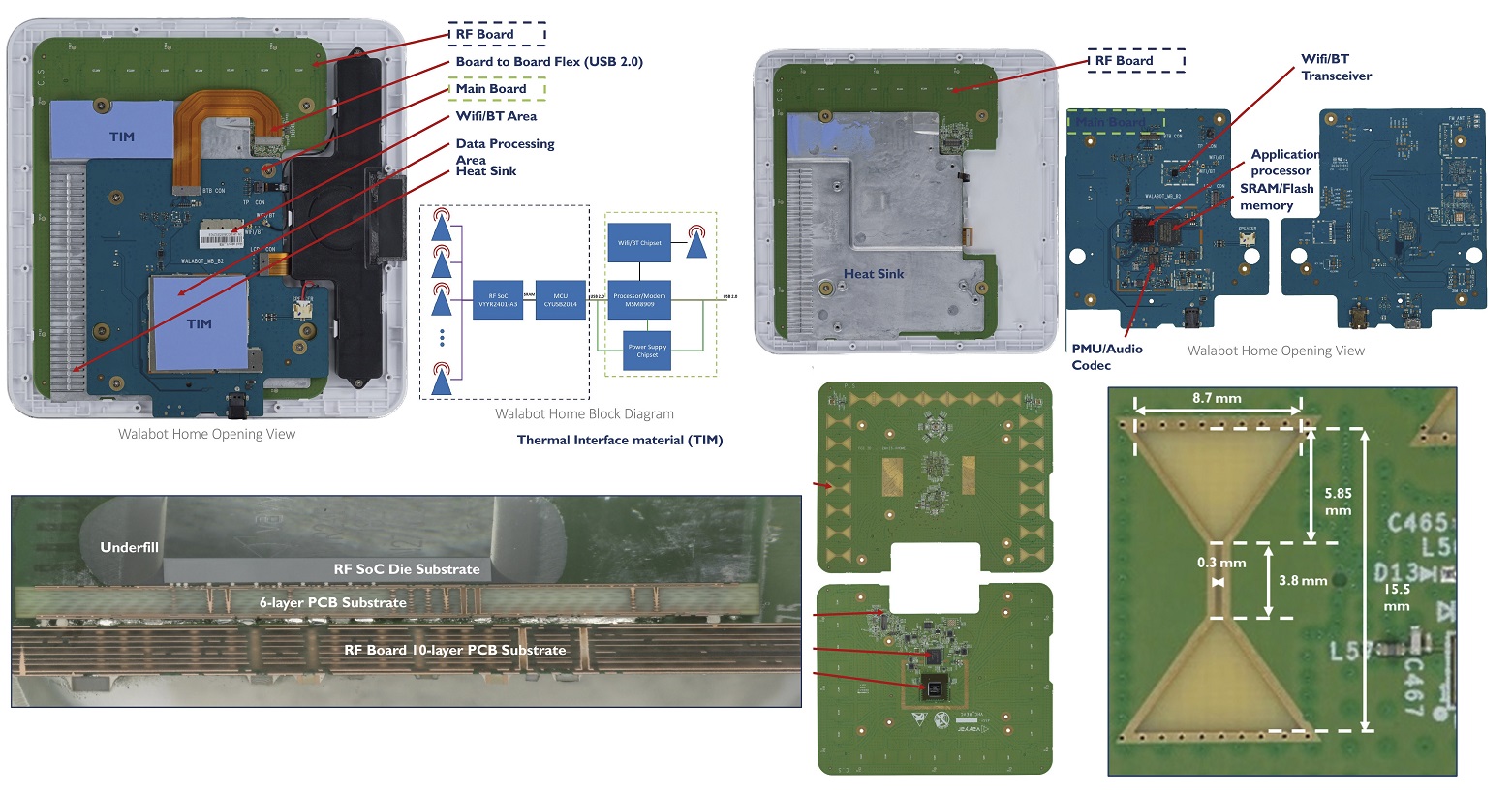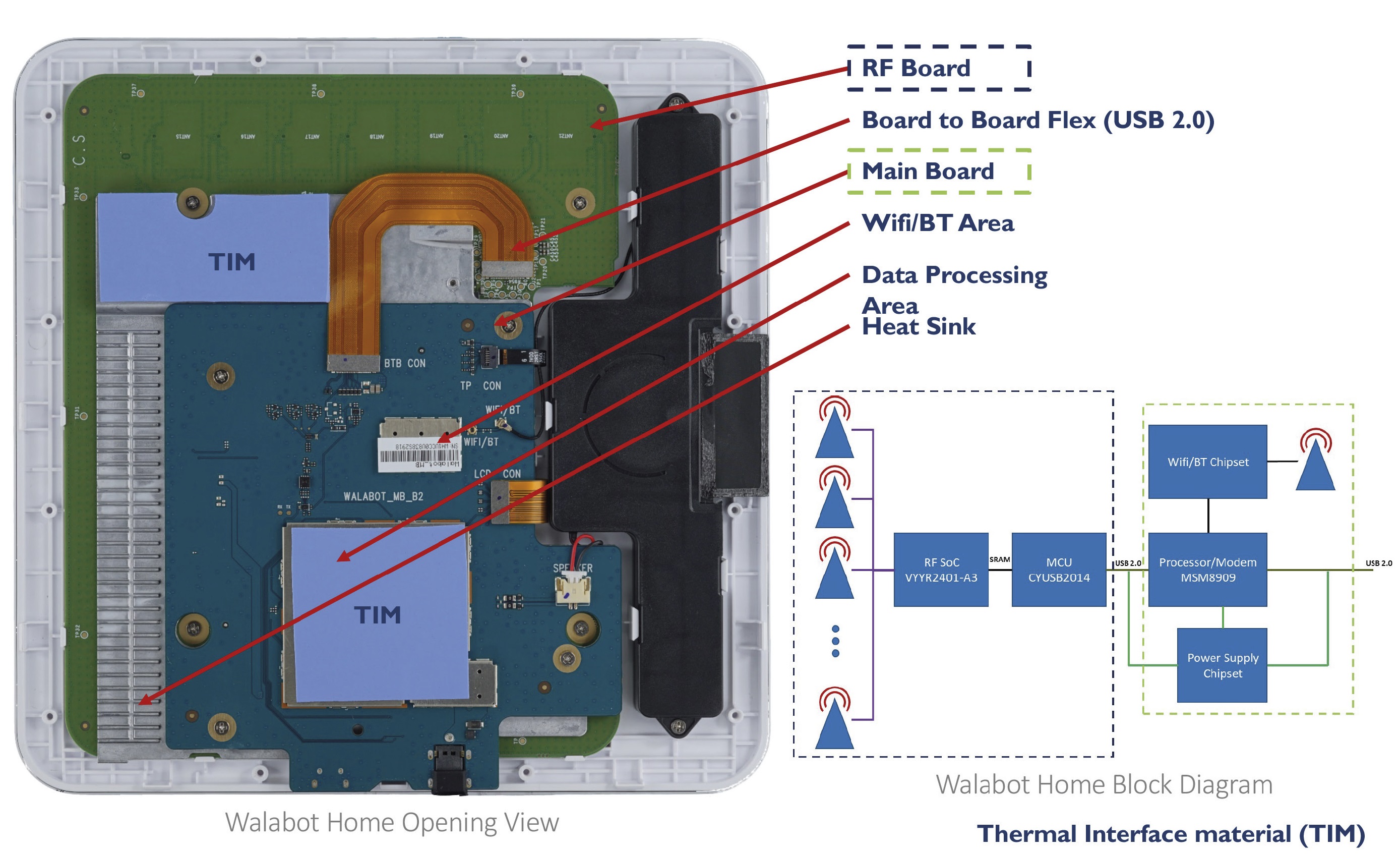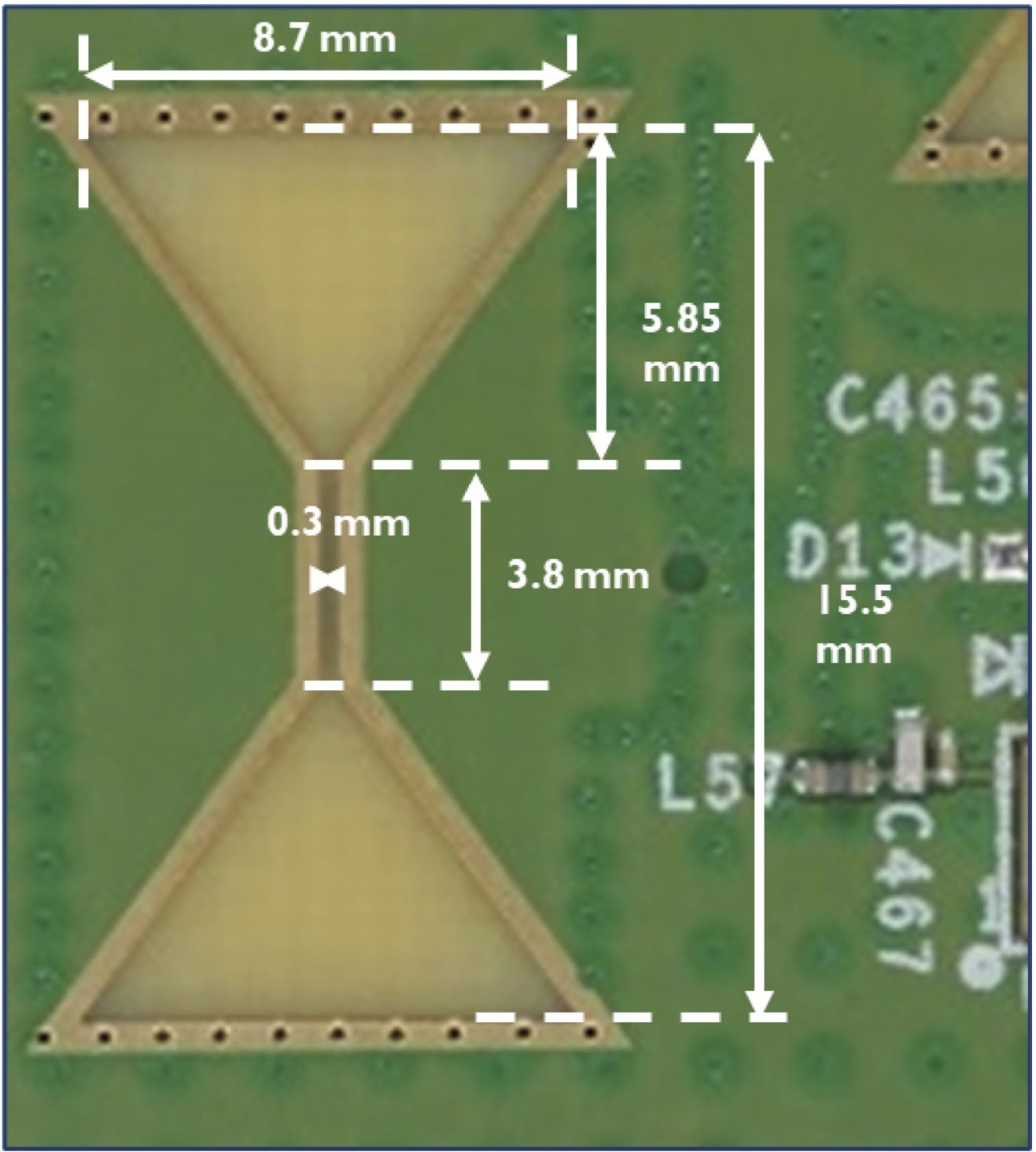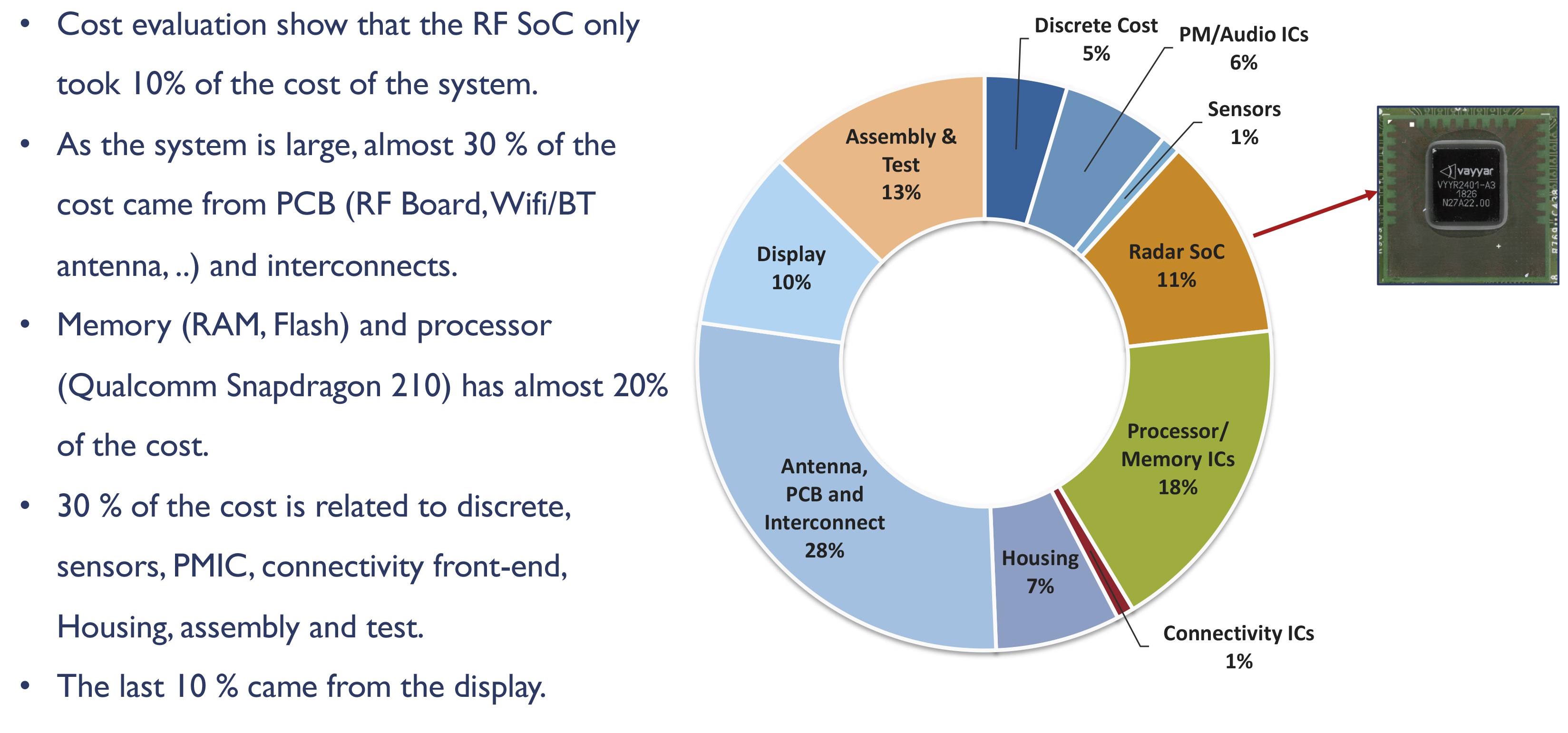
Today, radars are even used in consumer products, and System Plus Consulting employees are interested in their implementation. A technology and cost analysis company has decided to disassemble and examine a radar chip, but which one? The first-generation RF system from Vayyar was chosen as the analysis device for several reasons.
First, analysts at System Plus Consulting wondered how Vayyar was able to develop such a highly integrated single-chip RF system on a chip. The experts were also intrigued by the fact that this device can create high-resolution 4D images.
Previously, the radar market grew very slowly, and the sensors themselves were used in very mature industries (like the military). Now the state of affairs has changed significantly. Radars (especially those that can form images) are getting more attention than the Kardashians. Automotive and consumer applications are fueling the imagination of engineers, with the result that the number of new devices and their applications is growing in double digits.

While radars remain critical for military bases and aircraft carriers, they are also being deployed en masse in smart homes, family cars, and even smartphones. In automotive applications, Tier-1 and OEMs are now working on imaging radars for both ADAS and in-cabin activity detection.
Radar companies are also monitoring the functionality of smartphones. So, for example, the centerpiece of the collaboration between Infineon and Google (which was announced last year) was the introduction of gesture control technology in the Google Pixel 4 - this feature is based on Infineon's radar development. While it is not yet clear whether radars will be used in all phones, the scope of these sensors is expanding significantly.
Vayyar has developed its own RF chip as part of its Walabot product line. Walbot Home's fall monitoring system allows family members and caregivers to keep an eye on elderly relatives who may have stability issues.
The radar-based system can recognize people through walls and curtains. One of the advantages of this technology is that the person being monitored does not need to carry any wearable devices.
The experts from System Plus Consulting (part of the Yole Développement group) were intrigued by the Vayyar chip, which analyzes a variety of signals received from integrated transceivers and processes them using digital signal processors.
When we spoke with Stephan Elizabeth, a cost analysis expert at System Plus Consulting, he explained to us that Vayyar was able to design a small board that houses both an RF system on a chip and a microcontroller. This arrangement allows this device to work with any external processor installed by the system vendor.

The first generation Vayyar chips in question were based on RF chips operating at frequencies from 3 to 10 GHz. Considering the frequency range restrictions in force in different countries, Vayyar has already developed devices operating in the 57 to 64 GHz range, thus providing maximum bandwidth and high resolution spectrum. Also in the line there is a device operating in the range from 77 to 81 GHz.
According to System Plus Consulting, the RF system-on-a-chip comes with "an embedded signal processor with a lot of SRAM in the transceiver die." The RF system transmits data to the microcontroller located on the Walabot board. "The microcontroller only converts the data from the SRAM into a data stream for the USB interface." This step is critical because it makes the Vayyar system versatile and flexible, which allows it to be used with any external processor or processor chosen by the developers of a particular device. It doesn't matter if it's a Qualcomm Snapdragon processor or a processor for some other applications. Also, the chip from Vayyar can implement complex visualization algorithms (if necessary).
Outside Walabot Home
In addition to implementing Walabot Home, Vayyar is also entering the automotive market. Two years ago, Vayyar partnered with Valeo, a leading Tier-1 supplier. At the same time, Valeo announced plans to use Vayyar sensors to monitor babies' breathing and activate alarms in the event of an emergency (especially if the baby is left alone in the car).
Last November, Vayyar managed to raise $ 109 million in investment in Round D of Koch Disruptive Technologies (KDT), an investment subsidiary of the American multinational Koch Industries. Attracting KDT as a strategic investor was very important as Koch and its subsidiaries could potentially bring Vayyar sensors to different market segments.
Walabot Home System
Walabot Home is an intelligent system that tracks people's movements and determines if they have fallen and if they need help. The very small and thin device uses a sensor system that processes low-power radio waves (similar to Wi-Fi signals) to determine a person's location.
The RF system on a chip, the underlying system, combines transmitters and receivers operating in the 3 GHz to 81 GHz range to create high-resolution 4D images by analyzing multiple signals sent and received (all without an external processor) ... Thanks to the integration of transceivers and the high processing speed of the signal processor, the Vayyar system is capable of describing precise scenarios for various situations.
Through its Walabot Home system, Vayyar can display the size, position, movement and position of people and objects. This allows full recognition and classification of the environment in real time without using cameras. The lack of cameras for image processing means that the system is missing one of the potential privacy threats.
Walabot Home is a fall notification system that tracks people in need of care and continually prevents potentially dangerous situations and accidents. This smart home system can determine if a person has fallen while moving around the house and if he needs help.
RF system on a chip
The system supports UWB (ultra wide band) technology, which allows it to recognize people and determine their position in space. UWB transmits and receives signals using high frequency energy pulses of extremely short duration (from a few tens of picoseconds to a few nanoseconds). In practice, UWB is a wireless protocol that allows you to achieve a bandwidth of the order of gigabits per second with an antenna power of tenths of a watt (the FCC classifies a signal as UWB if its bandwidth is> 500 MHz or if its relative bandwidth exceeds 20%). The advantage of this technology is that the short pulse length makes the UWB signal less susceptible to interference due to reflections of the wave itself.
“One RF chip from Vayyar is used to transmit / receive RF signals in the 3.3 to 10 GHz range. The system uses two boards: one for the RF transceiver (yellow outline in Figure 1), data collection from SRAM memory and data transfer via the USB interface, and one (green outline in Figure 1) for data processing and connection to Bluetooth / Wi. -Fi "- this is how Stefan Elizabeth from System Plus Consulting explained to us.

Figure 1: X-ray of the Walabot Home system (Source: Report on Vayyar VYYR2401 4D UWB Radar Imaging SoC, System Plus Consulting, 2020) .

Figure 2: Block Diagram of Walabot Home System (Source: Report on Vayyar VYYR2401 4D UWB Radar Imaging SoC, System Plus Consulting, 2020).

Figure 3: Walabot Home System Main Board (Source: Vayyar VYYR2401 4D UWB Radar Imaging SoC Report, System Plus Consulting, 2020) .
The two boards shown in Figure 2 are connected using a Flex PCB for more flexibility. This flexibility saves space, weight and cost (compared to a comparable rigid base solution).
According to Stefan Elizabeth, heat dissipation is controlled in two ways: “The heat transfer material is placed in two places: above the processor and directly on the heatsink.” He also suggested that “the heatsink is made of an A380 aluminum alloy”.
A380 is one of the most commonly used aluminum alloys. A380 has excellent fluidity, tightness and crack resistance. In particular, the die casting of A380 aluminum alloy produces high quality, cost effective parts and durable products.
The RF chip has 48 I / O connecting the die to the balls under the housing. “Of the 48 inputs and outputs on the chip, only 42 are used for antenna communications. The RF system on a chip uses an integrated signal processor with a large amount of SRAM memory in the transceiver die and transmits data to the microcontroller. The microcontroller, in turn, converts the data from the SRAM into a data stream for the USB interface. An onboard signal processor removes the need for an external processor to run complex imaging algorithms, ”said Stefan Elizabeth.
The on-chip RF system uses a 6-layer PCB substrate that is soldered to another, 10-layer substrate (Figure 4). The packaging is made using FCBGA technology without a lid. An MMIC (Microwave Monolithic Integrated Circuit) consists of two quadrature oscillators that produce an intermediate signal on a chip that is processed by an ADC.

Figure 4: Cross-section of an RF system board on a chip (source: Vayyar VYYR2401 4D UWB Radar Imaging SoC report, System Plus Consulting, 2020).
In addition to the VYYR2401-A3 RF processor in the block diagrams in Fig. 2 and 3, we can see the MSM8909 processor providing emergency mobile communication between the device and the codec / audio interface using a Qualcomm speaker and microphone control device. The Qualcomm 210 MSM8909 is an entry-level system-on-a-chip designed for Android tablets and smartphones. The processor is equipped with four ARM Cortex-A7 cores with a frequency of 1.1 GHz.
The system-on-a-chip is equipped with Bluetooth 4.1 + BLE, 802.11n (2.4 GHz) WiFi modules and a 4G-LTE Category 4 modem (LTE FDD, LTE TDD, WCDMA (DC-HSDPA, HSUPA), CDMA1x, EV-DO Rev. B, TD-SCDMA and GSM / EDGE) and can operate at a maximum speed of 150 Mbps.
The Cypress CYUSB2014 controller sends the data processed by the system via the USB interface. The CYUSB2014 is a SuperSpeed peripheral controller offering flexibility and integration of various functions. This controller has a fully configurable GPIF II parallel programmable interface that can be connected to any processor (ASIC or FPGA). GPIF II is an improved version of GPIF from FX2LP, Cypress's flagship USB 2 device.
Antenna

The radar signal control board consists of 21 antennas providing high resolution. “The size of one antenna assumes that there is a large RF board in the system to handle 21 antennas,” said Stephen Elizabeth. Since the system operates at frequencies from 3 to 10 GHz, the antenna size is large (λ / 4 = ~ 15 mm). He also added that “the number of antennas connected is directly related to resolution. However, since this device operates at low frequencies, the size of the antennas is quite large. ”
“The operating frequency of this system is about 9.6 GHz and is based on the parameters of a bow tie antenna,” added Stephen Elizabeth.

Figure 5: RF board with 21 antennas (Source: Vayyar VYYR2401 4D UWB Radar Imaging Chip Report, System Plus Consulting, 2020).
The Bow-Tie design is widely used in imaging applications, radars, Wi-Fi access points and pulsed antennas due to its characteristics of low profile, high throughput, low loss, and high radiation efficiency (Figure 6).

Figure 6: Bow-tie antenna geometry (Source: Report on Vayyar VYYR2401 4D UWB Radar Imaging SoC, System Plus Consulting, 2020).
The bow-tie antenna design is a wire approximation (planar type variants) of the biconical dipole topology. Antenna design is ideal in size and cost, simple geometry and reliability. The bow-tie antenna provides good input impedance control and is easy to make.
Cost and analysis
System Plus Consulting conducted a cost estimate for the entire system, highlighting that only 10% of the total system cost was spent on the RF chip (Figure 7).

Figure 7: Walabot Home System Cost Analysis (Source: Vayyar VYYR2401 4D UWB Radar Imaging SoC Report, System Plus Consulting, 2020).
“Since the system is large, almost 30% of the cost is for the PCB (RF board, Wi-Fi / BT antenna, etc.) and interconnects. Memory (RAM, Flash) and processor (Qualcomm Snapdragon 210) account for almost 20% of the cost. 30% of the cost goes to discrete components - sensors, PMICs, connection interfaces. Another 10% goes to the display, ”said Stefan Elizabeth.

Figure 8: Other VYYR Chip Versions (Source: Vayyar Report VYYR2401 4D UWB Radar Imaging SoC, System Plus Consulting, 202 0).
Vayyar has also developed other versions of the chips that are already on the market. The operating frequencies of these models range from 60 to 80 GHz. VYYR7201-A0 operates at 57-64 GHz, while VYYR7202-A1 operates at 77-81 GHz. The former is presented in the Vayyar V60G-Home system and is suitable for gesture recognition applications as well as the detection of people in rooms and babies left in cars. It has 46 linear polarized PCB antennas. VYYR7202-A1 has 40 built-in polarized antennas, this chip is used in Vayyar V80G. It is suitable for use in and out of vehicles and for detecting potential intruders.
- Russia's first serial control system for a dual-fuel engine with functional separation of controllers
- In a modern car, there are more lines of code than ...
- - Automotive, Aerospace, (50+)
- McKinsey: automotive

, , , - .
, , , .
, , . , , , , , .
, , .
, , , .
, , . , , , , , .
, , .
- -
- -
- automotive . 2500 , 650 .
, , . ( 30, ), -, -, - (DSP-) .
, . , , , . , automotive. , , .
, , . ( 30, ), -, -, - (DSP-) .
, . , , , . , automotive. , , .
- - Automotive, Aerospace, (50+)
- [] (, , )
- DEF CON 2018-2019
- [] Motornet —
- 16 , 8
- open source
- McKinsey: automotive
- …